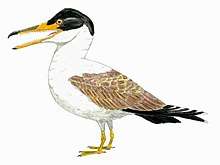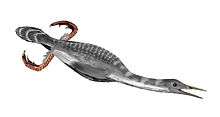Unenlagiinae
Unenlagiinae is a subfamily of dromaeosaurid theropods. Unenlagiines are known from South America and Antarctica. With possible Unenlagiines being known from North America, Madagascar, Europe, and even Australia.
| Unenlagiines | |
|---|---|
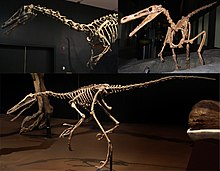 | |
| Skeletal mounts of two unenlagiines. From top left to right: Austroraptor and Buitreraptor. | |
| Scientific classification | |
| Kingdom: | Animalia |
| Phylum: | Chordata |
| Clade: | Dinosauria |
| Clade: | Saurischia |
| Clade: | Theropoda |
| Family: | †Dromaeosauridae |
| Subfamily: | †Unenlagiinae Bonaparte, 1999 |
| Type species | |
| †Unenlagia comahuensis Novas & Puerta, 1997 | |
| Genera | |
Description
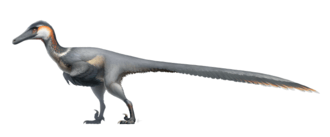
Most unenlagiines have been discovered in Argentina. The largest was Austroraptor, which measured up to 5–6 m (16.4–19.7 ft) in length, making it also one of the largest dromaeosaurids.[1] The subfamily is distinguished from other dromaeosaurids by a tail stiffened by lengthy chevrons and superior processes, a reduced second pedal ungual, a posteriorly oriented pubis and very elongated snouts. Unenlagiines also had elongated, slender hindlimbs with a subarctometatarsalian metatarsus, which is characterized by the pinched metatarsal III at the upper end. Their distinct anatomy from Laurasian dromaeosaurids was likely a consequence of the breakup of Pangaea into Gondwana and Laurasia, where the geological isolation of unenlagiines from their relatives resulted in allopatric speciation.[2][3]
Classification
During the description of Halszkaraptor in 2017, Cau et al. published a phylogenetic analysis of the Dromaeosauridae, in which, members of the Unenlagiinae are classified as:[4]
| Unenlagiinae |
| ||||||||||||||||||
In 2019, during the description of Hesperornithoides, many Paravian groups were examined for the inclusion of this new genus, including the Unenlagiinae. The analysis ended in the inclusion of Rahonavis, Pyroraptor, Dakotaraptor and Ornithodesmus to the Unenlagiinae.[5]
| Unenlagiinae |
| ||||||||||||||||||||||||||||||||||||||||||||||||
Paleobiology
.png)
A study performed by Gianechini and collaegues in 2020 indicates that unenlagiine dromaeosaurids of Gondwana possessed different hunting specializations than the eudromaeosaurs from Laurasia. The shorter second phalanx in the second digit of the foot of eudromaeosaurs allowed for increased force to be generated by that digit, which, combined with a shorter and wider metatarsus, and a noticeable marked hinge‐like morphology of the articular surfaces of metatarsals and phalanges, possibly allowed eudromaeosaurs to exert a greater gripping strength than unenlagiines, allowing for more efficient subduing and killing of large prey. In comparison, the unenlagiine dromaeosaurids possess a longer and slender subarctometatarsus, and less well‐marked hinge joints, a trait that possibly gave them greater cursorial capacities and allowed for greater speed than eudromaeosaurs. Additionally, the longer second phalanx of the second digit allowed unenlagiines fast movements of their feet's second digits to hunt smaller, faster types of prey. These differences in locomotor and predatory specializations may have been a key feature that influenced the evolutionary paths that shaped both groups of dromaeosaurs in the northern and southern hemispheres, respectively.[3]
References
- Novas, F. E.; Pol, D.; Canale, J. I.; Porfiri, J. D.; Calvo, J. O. (2008). "A bizarre Cretaceous theropod dinosaur from Patagonia and the evolution of Gondwanan dromaeosaurids". Proceedings of the Royal Society B: Biological Sciences. 276 (1659): 1101−1107. doi:10.1098/rspb.2008.1554. ISSN 1471-2954. PMC 2679073.
- Gianechini, F. A. (2011). "Unenlagiinae revisited: dromaeosaurid theropods from South America". Anais da Academia Brasileira de Ciências. 83 (1): 163−195. doi:10.1590/s0001-37652011000100009. PMID 21437380.
- Gianechini, F. A.; Ercoli, M. D.; Díaz-Martinez, I. (2020). "Differential locomotor and predatory strategies of Gondwanan and derived Laurasian dromaeosaurids (Dinosauria, Theropoda, Paraves): Inferences from morphometric and comparative anatomical studies". Journal of Anatomy. 236 (5): 772−797. doi:10.1111/joa.13153. PMC 7163733. PMID 32023660.
- Cau, A.; Beyrand, V.; Voeten, D. F. A. E.; Fernandez, V.; Tafforeau, P.; Stein, K.; Barsbold, R.; Tsogtbaatar, K.; Currie, P. J.; Godefroit, P. (2017). "Synchrotron scanning reveals amphibious ecomorphology in a new clade of bird-like dinosaurs". Nature. 552 (7685): 395−399. Bibcode:2017Natur.552..395C. doi:10.1038/nature24679. PMID 29211712.
- Hartman, S.; Mortimer, M.; Wahl, W. R.; Lomax, D. R.; Lippincott, J.; Lovelace, D. M. (2019). "A new paravian dinosaur from the Late Jurassic of North America supports a late acquisition of avian flight". PeerJ. 7: e7247. doi:10.7717/peerj.7247. PMC 6626525. PMID 31333906.
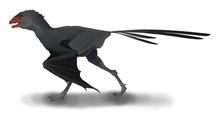

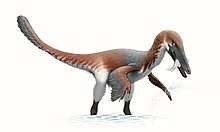
.png)



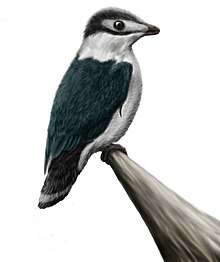

.png)

